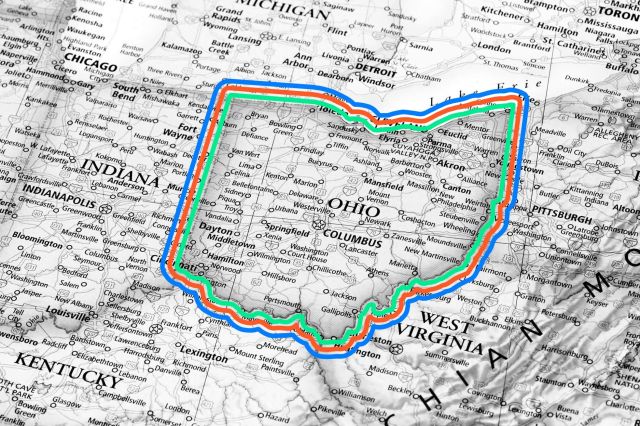
Colorado, The Centennial State
Colorado joined the union as a state in 1876 — exactly 100 years after the signing of the Declaration of Independence. Thus, Colorado became known as the Centennial State. Unofficially, the state is often referred to as “Colorful Colorado” for its unspoiled mountain backdrops and colorful vistas. In fact, the state’s department of transportation famously erects “Welcome to Colorful Colorado” signs along many of the state’s highways.

Iowa, The Hawkeye State
Iowa’s nickname is in honor of a Native American leader and warrior of the Sauk tribe. A veteran of the War of 1812 and the Black Hawk War, Chief Black Hawk’s personal memoir was the first Native American autobiography published in America. He died in 1838 in Davis County, Iowa, where a local newspaper publisher renamed his paper The Hawk-Eye and Iowa Patriot in his honor. The Hawkeye State nickname was made official in 1838, before Iowa even became a state.

Connecticut, The Constitution State
In 1959, Connecticut’s general assembly declared a state nickname — the Constitution State. The reason behind the moniker: a series of government documents adopted by the Connecticut Colony council entitled the Fundamental Orders of 1638-39 that were actually the first written rules of government used in the United States. The orders may very well be the first written constitution in American history, and it’s certainly safe to say they laid the groundwork for the United States Constitution. So, even though the nickname only became official in the 1950s, Connecticut earned it!
More Interesting Reads

Ohio, The Buckeye State
Ohio’s Buckeye State nickname stems from the buckeye trees that proliferate within the state’s natural spaces, specifically broad grasslands and low hills. These trees famously bear nuts that Native Americans and early settlers likened to the eyes of male deer — or bucks. The buckeye is even the official state tree, designated by Ohio legislature in 1953.
That said, the moniker is more than this native tree — Ohioans have been referring to themselves as Buckeyes at least since the presidential election of 1840, when Ohio resident William Henry Harrison ascended to the Oval Office. The politician’s supporters used buckeye wood to fashion carved campaign souvenirs in support of Harrison (who only served 31 days in office before succumbing to pneumonia.

Indiana, The Hoosier State
Per the Indiana State Library, the Hoosier State nickname comes from a poem called “The Hoosier’s Nest.” Published in The Indianapolis Journal in 1833, the poem inspired Indianians to adopt the nickname — possibly starting at a Jackson Day dinner in Indianapolis that same year and becoming widely used to describe state residents by the 1930s. Why Hoosier? The state’s historical bureau points to one Samuel Hoosier as the source. A contractor, Hoosier preferred Indiana laborers for his various projects. Of course, the moniker grew even more popular after a movie of the same name was released in 1986. Set in the 1950s, the Oscar-nominated film tells the story of a high school basketball team participating in an Indiana state championship.

Maryland, The Old Line State
According to state government officials in Maryland, historians believe the Old Line State nickname came directly from General George Washington in tribute to the colony’s Line Regiment troops, who bravely served under him in the Revolutionary War. The Old Line term — which Marylanders adopted and still use widely — was common in Washington’s writings. But Maryland is sometimes referred to as the Free State as well. That unofficial moniker refers to the state’s abolition of slavery in its constitution back in 1864.

Missouri, The Show-Me State
Missouri’s nickname dates back to 1899. In a speech at a Philadelphia naval banquet, Missouri Congressman Willard Duncan Vandiver famously stated, “Frothy eloquence neither convinces nor satisfies me. I am from Missouri. You have got to show me.” He was speaking of his personal conservative and sometimes skeptical stance — one he believed reflected the spirit of Missourians who (sometimes stubbornly) subscribe to common sense values. All that said, the nickname is widely used across Missouri today — but only unofficially.

Montana, The Treasure State
Montana’s nickname — the Treasure State — refers to its rich mineral reserves, including its gold and silver mines. The state motto refers to these treasures as well: It’s “oro y plata,” Spanish for “gold and silver.” Such an abundance of riches has fed a thriving mining industry since the late 19th century (the nickname was coined in 1895). One of Montana’s unofficial nicknames is a bit less glamorous, however. First published in 1922, the “Stubbed-Toe State” moniker relates to many injuries an amateur hiker adventuring through Montana will likely face.

New Mexico, The Land of Enchantment
The Land of Enchantment nickname refers to New Mexico’s magical and often otherworldly beauty, which ranges from desert dunes and red rock formations to evergreen forests, and includes sites such as the White Sands National Monument, the Rio Grande Gorge, and the Capulin Volcano. The name only became official in 1999, and it derives from a Lilian Whiting book of the same name that espouses the unique beauty of America’s Southwest. Before 1999, New Mexico test-drove other nicknames including the Land of the Heart’s Desire, the Land Without Law, the Science State, and many others.











